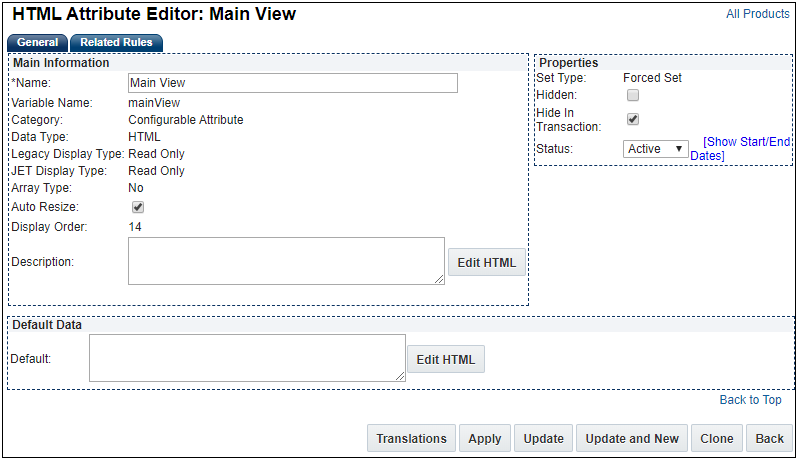Overview
You can insert customer HTML in a configuration page by defining an HTML type attribute at any level in the product hierarchy. These attributes can be associated with default or custom templates in the configuration or selection flows. HTML attributes can be used as action attributes in Recommendation and Hiding rules. In Recommendation rules, they must be of forced set type.
Configuration HTML attributes are carried to Commerce like other Configuration attributes. They can be displayed in the Transaction as well as in printer-friendly documents.
Administration
![]() Accessing the HTML Attribute Editor Page
Accessing the HTML Attribute Editor Page
![]() Using the HTML Attribute Editor Page
Using the HTML Attribute Editor Page
![]() Using HTML Attributes in Printer-Friendly Documents
Using HTML Attributes in Printer-Friendly Documents
Adding an HTML Attribute Watch Video 
Editing an HTML Attribute Watch Video 
Use Cases
![]() Changing an image based on menu selection
Changing an image based on menu selection
Notes
Note: Customers should not use any of the following names for Configuration attribute variable names. Using these values may cause issues with customer configurations and could possibly alter site functionality.
action_idbm_cm_process_id_bom_bs_idcommerce_doc_url_paramscommerce_list_iddocument_iddocument_numberfolder_idformactionfrom_configscrollTopshopping_cart_idstep_idtokenversion_id
-
Ill-constructed HTML can break Configuration Layouts, so the FullAccess user must be very careful about setting values for HTML fields.
-
HTML attributes cannot be used as a rule condition or in configuration arrays.
-
Date and HTML attributes cannot be menus.
-
HTML attributes cannot be used in an array.
-
Have as few attributes "auto-update" as possible.
Notes:
-
HTML attributes are used as strings when debugging Recommendation rules.
-
HTML attributes are marked as 'hide in transaction' by default, for performance reasons. Deselect this if you need to use them in Commerce or the Document Engine.
-
Content of the HTML attributes is rendered as unparsed text in the Commerce sub-document.
-
Using CDATA tags in a Configuration HTML attribute will prevent Pending Configurations from saving, if saving Pending Configurations is enabled on the site. CDATA tags are automatically added to the default of the attribute if a <script> tag is used when editing via the Edit HTML window. Whether the HTML contains a CDATA tag because of this, manual addition in the default, or being set by a rule, the CDATA tag should not be used if Pending Configurations are required to be saved.
-
Using CDATA tags in a Configuration HTML attribute will cause system configuration navigation errors. This is true if the CDATA tag is directly used in a product family configuration or inherited from an all product family level.










